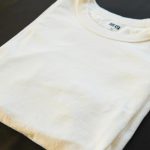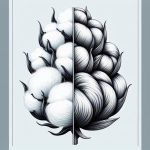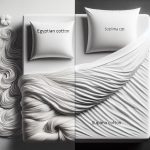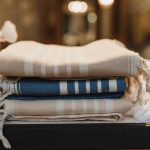Are you unsure about which cotton fabric is the best for your needs? Look no further! In this article, we will explore the various types of cotton fabrics available and their unique qualities.
From the benefits of organic cotton to the softness and durability of Supima cotton, we will provide you with all the information you need to make an informed decision.
So, let’s dive in and discover which cotton fabric is the perfect fit for you!
Table of Contents
The Benefits of Organic Cotton
If you’re looking for a fabric that is better for both you and the environment, organic cotton is the way to go. Organic cotton has several advantages over conventional cotton that make it a sustainable choice.
First and foremost, organic cotton is grown without the use of synthetic fertilizers or pesticides. This reduces the environmental impact and promotes healthier soil and water systems. Additionally, organic cotton farming practices prioritize biodiversity and conservation, which helps protect ecosystems and wildlife.
Moreover, organic cotton is better for human health. Conventional cotton production involves the use of harmful chemicals that can be absorbed by the skin and cause allergies or skin irritations. Organic cotton, on the other hand, is free from these toxic substances, making it a safer choice for individuals with sensitive skin or allergies.
In terms of durability, organic cotton is just as strong and long-lasting as conventional cotton. It can withstand regular wear and tear, making it a practical choice for everyday clothing. Furthermore, organic cotton garments are often softer and more comfortable to wear due to the absence of harsh chemicals.
Overall, choosing organic cotton is a sustainable decision that benefits both the environment and your well-being. Its advantages include reduced environmental impact, better human health, and durable, comfortable clothing options. By opting for organic cotton, you are supporting a more sustainable and ethical fashion industry.
Understanding the Differences Between Egyptian and Pima Cotton
When it comes to choosing the best cotton fabric, it’s important to understand the differences between Egyptian and Pima cotton. These two types of cotton are known for their high quality, but they have distinct characteristics that set them apart.
One key factor to consider is the thread count variations, as well as the softness and durability of the fabric.
Quality Differences: Egyptian Vs. Pima
There’s a clear distinction in quality between Egyptian and Pima cotton fabrics. Egyptian cotton is known for its luxurious feel and exceptional durability, making it highly sought after in the textile industry. Pima cotton, on the other hand, is also renowned for its softness and strength, but it is generally considered to be slightly inferior to Egyptian cotton. This is mainly due to the fact that Egyptian cotton has longer fibers, which result in smoother and more lustrous fabrics. Additionally, Egyptian cotton is often produced using organic farming methods, which have a lower environmental impact compared to conventional farming practices used for Pima cotton. This table highlights the key differences between the two fabrics:
| Aspect | Egyptian Cotton | Pima Cotton |
|---|---|---|
| Fiber Length | Long | Medium |
| Fabric Quality | Luxurious | High |
| Production Methods | Organic | Conventional |
Thread Count Variations
The thread count varies between Egyptian and Pima cotton, affecting the overall texture and softness of the fabric. Thread count refers to the number of horizontal and vertical threads per square inch. Higher thread counts are often associated with a softer and smoother feel.
However, it’s important to note that thread count alone does not determine the quality of the fabric. The type of weave used also plays a significant role in the fabric’s feel and durability. There are different types of weaves, such as percale and sateen, which can affect the fabric’s texture and appearance.
Percale weave, for example, creates a crisp and breathable fabric, while sateen weave produces a lustrous and silky fabric. So, while thread count is important, it’s essential to consider the type of weave as well when choosing the best cotton fabric for your needs.
Softness and Durability
To ensure softness and durability, you should consider factors like thread count and weave when selecting your cotton fabric.
Softness refers to the tactile feel of the fabric against your skin, while comfort is the overall feeling it provides.
On the other hand, durability refers to the fabric’s ability to withstand wear and tear, while longevity is its lifespan.
When it comes to softness, higher thread count fabrics tend to be smoother and more luxurious. However, they may sacrifice some durability and longevity.
Fabrics with a lower thread count may not be as soft, but they often offer better durability and longevity.
Ultimately, finding the right balance between softness and durability is key in selecting the best cotton fabric for your needs.
Exploring the Softness and Durability of Supima Cotton
You’ll love the softness and durability of Supima cotton fabric.
When it comes to finding alternatives to Supima cotton, there are several sustainable cotton options available.
One such option is organic cotton. Grown without the use of synthetic fertilizers and pesticides, organic cotton is not only gentle on your skin but also on the environment.
Another alternative is recycled cotton, which is made from post-industrial and post-consumer waste. By repurposing and reusing cotton fibers, this option helps reduce waste and conserve resources.
Additionally, there is also Fairtrade cotton, which ensures fair wages and good working conditions for cotton farmers. This option promotes ethical and sustainable practices in the cotton industry.
While these alternatives offer their own unique benefits, Supima cotton remains a popular choice due to its exceptional softness and durability.
With its extra-long staple fibers, Supima cotton fabric is known for its luxurious feel and strength, making it perfect for everyday wear and long-lasting garments.
The Breathability and Moisture-wicking Properties of Bamboo Cotton
If you’re in need of a breathable and moisture-wicking fabric, bamboo cotton is a great choice. Bamboo cotton offers several benefits when it comes to breathability.
The natural fibers of bamboo cotton allow air to circulate more freely, keeping you cool and comfortable throughout the day. This makes it an excellent option for hot and humid climates, or for those who tend to sweat a lot.
Additionally, bamboo cotton has moisture-wicking properties, which means it can effectively absorb and evaporate sweat from your body, keeping you dry and preventing any uncomfortable clamminess. This is especially beneficial during physical activities or intense workouts.
Bamboo cotton is also hypoallergenic, making it suitable for those with sensitive skin or allergies. It is known for being soft and gentle on the skin, providing a comfortable and irritation-free experience.
Comparing the Strength and Versatility of Denim Cotton
When it comes to durability and versatility, denim cotton is a material that can withstand heavy use and be styled in various ways. Compared to other fabrics, denim is known for its strength and durability. The tightly woven fibers of denim make it resistant to tearing and fraying, making it ideal for clothing items that need to withstand frequent use, such as jeans or jackets. Denim’s strength is also evident in its ability to retain its shape and structure over time.
In addition to its strength, denim cotton is also highly versatile. It can be dyed in a wide range of colors and patterns, allowing for endless style possibilities. Whether you prefer a classic indigo hue or a bold, vibrant shade, denim can be transformed to suit your personal taste. Furthermore, denim cotton can be washed and treated to achieve different finishes, such as distressed or worn-in looks.
Understanding the strength and versatility of denim cotton allows you to make informed choices when it comes to selecting clothing or home decor items. Whether you’re looking for a durable pair of jeans or a stylish denim jacket, denim cotton is a reliable choice that will last for years to come.
The Luxurious Feel and Luster of Sateen Cotton
When it comes to choosing between Sateen and Percale cotton, durability and longevity are two key factors to consider.
Sateen cotton is known for its luxurious feel and lustrous appearance, making it a popular choice for bedding and linens. However, while Sateen may offer a softer and smoother texture, it is generally less durable than Percale cotton, which has a crisper and more matte finish.
Ultimately, the decision between Sateen and Percale will depend on your personal preferences and priorities, whether it’s the luxurious feel or the longevity of the fabric.
Sateen Vs. Percale
To determine which cotton fabric is best for you, compare the luxurious feel of sateen with the crispness of percale. Sateen is known for its smoothness factor, achieved through a unique weave technique. The high thread count and satin weave of sateen create a lustrous fabric that feels incredibly soft and silky against your skin. On the other hand, percale is woven in a crisscross pattern, resulting in a crisp and cool texture. It has a lighter weight and a matte finish, making it ideal for those who prefer a more breathable and crisp feel. Consider your personal preferences and desired comfort level when choosing between sateen and percale.
| Sateen | Percale | |
|---|---|---|
| Softness | Luxurious | Crisp |
| Texture | Smooth and silky | Cool and crisp |
| Weight | Heavier | Lighter |
| Shine | Lustrous | Matte |
| Breathability | Less breathable | More breathable |
Durability and Longevity
Consider the durability and longevity of each fabric option before making your decision.
When it comes to cotton fabrics, durability is often weighed against price, while longevity is compared to maintenance.
Sateen, a cotton fabric known for its luxurious feel and subtle sheen, is generally less durable than percale. It has a satin weave that makes it prone to snagging and tearing over time. However, sateen is often more affordable than percale, making it a popular choice for those on a budget.
On the other hand, percale, with its crisp and cool feel, is known for its durability. It has a plain weave that makes it less prone to pilling and fading. Although percale may require more maintenance, it tends to last longer, making it a worthwhile investment for those seeking longevity.
Ultimately, the choice between sateen and percale depends on your priorities: price or durability, maintenance or longevity.
Exploring the Lightweight and Breathable Nature of Voile Cotton
Take a look at voile cotton for a lightweight and breathable fabric option. Voile cotton is known for its lightweight properties and breathability benefits, making it an excellent choice for warm weather or when you want to stay cool and comfortable throughout the day.
Here are five reasons why voile cotton is a great fabric choice:
-
Soft and Smooth: Voile cotton is made from fine, tightly woven yarns, resulting in a fabric that feels soft and smooth against your skin. This adds to the overall comfort and breathability of the fabric.
-
Airy and Lightweight: Due to its loose weave, voile cotton allows air to circulate freely, keeping you cool even in hot and humid conditions. It is also incredibly lightweight, making it easy to wear and move around in.
-
Moisture-Wicking: Voile cotton has excellent moisture-wicking properties, meaning it absorbs and evaporates moisture quickly. This helps to keep you dry and sweat-free, even during intense physical activities.
-
Versatile and Stylish: Voile cotton is versatile and can be used for a variety of garments and accessories. Whether you’re looking for a flowy summer dress, a lightweight shirt, or a stylish scarf, voile cotton has got you covered.
-
Easy to Care for: Voile cotton is easy to care for and can be machine washed and dried. It also tends to resist wrinkling, so you can spend less time ironing and more time enjoying your day.
The Coziness and Warmth of Flannel Cotton
If you’re looking for a cozy and warm fabric option, flannel cotton is perfect for you. Flannel cotton is renowned for its exceptional coziness and warmth properties, making it a top choice for those seeking comfort during colder months.
The secret behind its coziness lies in the unique way it is woven. Flannel cotton is made from loosely spun yarns that are then brushed on one or both sides, resulting in a soft and fuzzy texture. This brushing process creates tiny air pockets within the fabric, which helps to trap heat and provide insulation.
As a result, flannel cotton is incredibly warm and cozy, making it ideal for blankets, pajamas, and cold-weather clothing. In addition to its warmth properties, flannel cotton also offers other benefits. It is highly durable and has excellent moisture-wicking capabilities, keeping you dry and comfortable throughout the day.
Moreover, flannel cotton is easy to care for, as it is machine washable and resistant to shrinking. So, if you’re in need of a fabric that combines coziness, warmth, and practicality, look no further than flannel cotton.
Conclusion
In conclusion, when it comes to choosing the best cotton fabric, it ultimately depends on your specific needs and preferences.
If you prioritize environmental sustainability, organic cotton is a great option.
For a soft and durable fabric, consider Egyptian or Pima cotton.
Supima cotton offers excellent breathability and moisture-wicking properties.
Denim cotton is known for its strength and versatility.
If you prefer a luxurious feel, Sateen cotton is the way to go.
Voile cotton is lightweight and breathable, while flannel cotton provides coziness and warmth.
Ultimately, the best cotton fabric for you will depend on the qualities you value most.
- Tetron Fabric for Marine Applications: Durability and Use Cases - June 18, 2025
- Tetron Fabric for Outdoor Furniture: Weather Resistance and Care - June 18, 2025
- Tetron Fabric for Wall Coverings: Style and Application Tips - June 18, 2025






